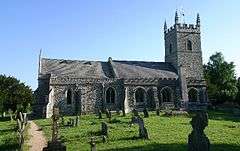Horringer
Horringer is a village and civil parish in the West Suffolk district of Suffolk in eastern England. It lies on the A143 about two miles south-west of Bury St Edmunds. The population in 2011 was 1055.[1]
| Horringer | |
|---|---|
 St Leonard's Church, Horringer | |
 Horringer Location within Suffolk | |
| Population | 890 (2005)[1] 1,055 (2011)[2] |
| District | |
| Shire county | |
| Region | |
| Country | England |
| Sovereign state | United Kingdom |
| Post town | Bury St Edmunds |
| Postcode district | IP29 |
| Police | Suffolk |
| Fire | Suffolk |
| Ambulance | East of England |
Heritage
Horringer was earlier known as Horningsheath. The school kept this spelling until after the Second World War.[3]
The village includes the main entrance to Ickworth house, a Neoclassical country house which was the seat of the Earls and Marquesses of Bristol until the 7th Marquess sold the lease to the National Trust.
Notable persons
In birth order:
- Thomas Rogers (c. 1553–1616), a religious controversialist and cleric was the Rector of St Leonards, Horringer, from 1581 until his death.[4]
- Elizabeth Cavendish, Duchess of Devonshire, born Elizabeth Christiana Hervey in Horringer on 13 May 1759, became a notable society hostess and patron of the arts.[5] Her father, Frederick Hervey, 4th Earl of Bristol, later became Bishop of Cloyne (1767–1768) and Bishop of Derry (1768–1803). He believed in equality among religions.[6]
- Melmoth Hall (1811–1885), born here, became a first-class cricketer in Australia.[7]
- The remains of Victor Hervey, 6th Marquess of Bristol (1915–1985) were brought home from Menton, France, by his son in 2010, for a funeral at Horringer before burial at Ickworth.[8]
Demography
According to the Office for National Statistics, Horringer at the time of the United Kingdom Census 2001 had a population of 901 in 397 households.[9] increasing to a population of 1,055 at the 2011 Census.
Population change
| Population growth in Horringer from 1801 to 1891 | ||||||||||
|---|---|---|---|---|---|---|---|---|---|---|
| Year | 1801 | 1811 | 1821 | 1831 | 1841 | 1851 | 1881 | 1891 | ||
| Population | 543 | 523 | 539 | 586 | 597 | 670 | 662 | 599 | ||
| Source: A Vision of Britain Through Time[10] | ||||||||||
| Population growth in Horringer from 1901 to 2001 | |||||||||||
|---|---|---|---|---|---|---|---|---|---|---|---|
| Year | 1901 | 1911 | 1921 | 1931 | 1951 | 1961 | 2001 | 2011 | |||
| Population | 525 | 552 | 569 | 545 | 465 | 468 | 901 | 1,055 | |||
| Source: A Vision of Britain Through Time[10] | |||||||||||
Location grid
gollark: Any specific thingies it's missing?
gollark: You can use luadash.
gollark: ```rust#[macro_use] extern crate serenity;extern crate dotenv;use serenity::client::{Client, EventHandler};use serenity::framework::standard::StandardFramework;use std::env;struct Handler;impl EventHandler for Handler {}pub fn main() { dotenv::dotenv().ok(); // Load bot token from environment, let mut client = Client::new(&env::var("DISCORD_TOKEN").expect("token unavailable"), Handler) .expect("Error creating client"); client.with_framework(StandardFramework::new() .configure(|c| c.prefix("~")) .cmd("ping", ping)); if let Err(why) = client.start() { eprintln!("An error occured: {:?}", why); }}command!(ping(_context, message) { let _ = message.reply("Pong!");});```Fun with discord bots, and yes this is literally the example code.
gollark: t r a i t o r
gollark: f i b o n a c c i
References
- Estimates of Total Population of Areas in Suffolk Suffolk County Council
- "Civil Parish population 2011". Neighbourhood Statistics. Office for National Statistics. Retrieved 23 August 2016.
- Horringer Village. Retrieved 31 March 2014.
- ODNB: John Craig, "Rogers, Thomas (c. 1553–1616)" Retrieved 30 March 2014, pay-walled
- ODNB: Amanda Foreman, "Cavendish , Elizabeth Christiana, duchess of Devonshire (1757–1824)" Retrieved 30 March 2014, pay-walled.
- ODNB: Gerard O'Brien, "Hervey, Frederick Augustus, fourth earl of Bristol (1730–1803)" Retrieved 30 March 2014, pay-walled.
- "Melmoth Hall". ESPN Cricinfo. Retrieved 29 January 2015.
- Haden-Guest, Anthony. "The end of the peer", The Observer, 22 January 2006. Accessed May 17, 2008.
- "Suffolk County Council – 2001 Census Profiles" (PDF). Archived from the original (PDF) on 28 September 2011. Retrieved 22 February 2011.
- "A Vision of Britain Through Time". University of Portsmouth & others. Retrieved 22 February 2011.
This article is issued from Wikipedia. The text is licensed under Creative Commons - Attribution - Sharealike. Additional terms may apply for the media files.